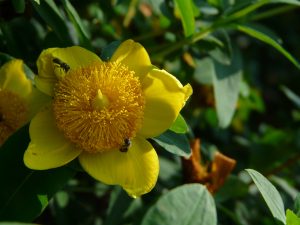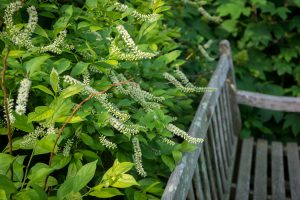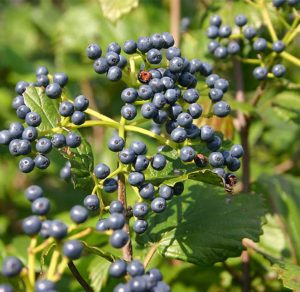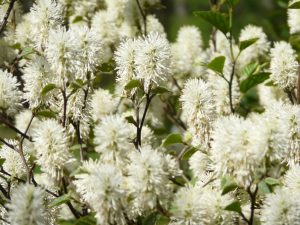Small but Mighty
Photos courtesy of Jenkins Arboretum & GardensPlant native shrubs as an alternative to trees in small landscapes

When I think of my childhood home, I picture the large shady silver maple (Acer saccharinum) I sat under on hot August days. Sadly, most places I’ve lived since leaving home could not accommodate a tree that size. But I’ve found alternatives.
Every property has its limitations, and finding a plant that can thrive in a smaller yard can be a challenge. Some trees, like flowering dogwood (Cornus florida) and eastern redbud (Cercis canadensis), maintain a smaller understory height, but still take up more space than many home gardeners would prefer.
For gardeners who want to have the impact of a large tree but are tight on space, native shrubs offer an easily maintained, beautiful and ecologically beneficial alternative for smaller spaces. Happily, homeowners have a variety of shrubs to choose from when designing their landscape.
Here are a few suggestions to add beauty and value to your yard during the autumn season.
Aesthetic Value

Shrubs contribute ornamental value to the yard, lending character and shape as they mature. Shrubs can display a range of colors — their pleasant greens in the spring and summer often change into reds, purples, yellows and oranges in the fall. When they bloom, their flowers offer vibrant splashes of color, and many have the added bonus of pleasant fragrances or ornamental fruits.
A native counterpart to a popular landscape plant, smooth hydrangea (Hydrangea arborescens) sports blooms that emerge in summer. The lace-cap flowers are valuable to pollinators and are visually appealing around the home.

For a pop of color, Kalms St. John’s wort (Hypernicum kalmianum) is a great option. This shrub is known for its contained, low-growth habit, perfect for small gardens. It’s a pollinator powerhouse in mid-summer, with bees covering its yellow blooms. Finches will feed on its seeds throughout the late summer and fall.
Summersweet clethra (Clethra alnifolia) is another eye-catching plant with fragrant, long white spires of flowers in mid-summer. It’s a popular pollinator plant, always covered in bees and butterflies, and it provides brown fruit in the late summer and fall that serve as a valuable food source for birds throughout the winter. In the fall, its leaves turn a pleasant golden color.
Ecological Benefit

Native shrubs are more than just a pretty face. These ecological all-stars also provide habitat for birds and mammals within their dense foliage and branches. And their flowers often provide nectar and pollen to a variety of pollinators, such as bees, butterflies, wasps, moths and hummingbirds. From late summer through the winter, many shrubs also provide nutritious seeds and fruit to wildlife around the home.
Arrowwood viburnum (Viburnum dentatum) is one shrub with a particularly high ecological value. This ornamental native shrub attracts pollinators to its delicate white blooms and hosts larval species, such as the spring azure butterfly, on its flowers. Throughout the fall, the shrub’s foliage deepens into a vibrant reddish color, and it produces nutrient-dense, blue-colored berries berries that birds love.

Another great shrub with high ecological value is our native black chokeberry (Aronia melanocarpa). This shrub is often used for wetland restoration proects and provides ecological value as a larval host to many moths and butterflies. Its white clustered blooms appear in late spring, and the foliage turns a reddish-purple color in the fall. Its dark-colored fruits develop in the winter and provide food for birds throughout the season.
For a lankier option, consider serviceberry (Amelanchier canadensis), a tall shrub known for its delicate vase structure. It’s a larval hots to both the tiger swallowtail and viceroy butterfly and provides pollinator value with its vibrant white spring flowers. In late spring, birds rely on the blue-colored berries for nutrition.
Easy Maintenance

Shrubs have the additional benefit of being simple to maintain. Due to their lower height, they can be tended from the ground, making them easy to prune as they develop. They typically don’t require the same level of leaf cleanup as most overstory trees and, thanks to their more fibrous root system, they’re not prone to disturbing pavement like many trees do as they age.
One easy-to-maintain shrub is Virginia sweetspire (Itea virginica), with delicately arching branches. This plant blooms in late spring with a light fragrance from its white spire flowers. As the season changes to fall, the foliage turns a vibrant reddish-orange color. It’s great for a home landscape, tolerating poor soils and retaining an arched shape.

A relative of witch hazel, dwarf fothergilla (Fothergilla gardenii) flowers in early to mid-spring, providing early food for pollinators with its white pom-pom blooms. In the fall, the foliage develops a stunning palette of yellows, oranges and maroons that are arguably showier than the flower. This shrub is particularly low maintenance and keeps a compact form.
All these plants — and many more — are readily available at native plant nurseries in the region, including the Garden Shop at Jenkins Arboretum & Gardens. No matter the size of your garden, native shrubs will add beauty, ecological benefits and easy maintenance to your landscape.
Jenkins Arboretum & Garden is a 48-acre public garden showcasing native flora of the eastern United States and a world-class collection of rhododendron and azaleas. The gardens are open every day of the year and are always free. 631 Berwyn Baptist Rd., Devon. Plan your visit by visiting Jenkins online at JenkinsArboretum.org.
Our Favorite Resources
- Arrowwood Landscape Design
- B&D Builders
- Ball & Ball
- Berk Hathaway Country Prop
- Berk Hathaway Holly Gross
- Berk Hathaway Missy Schwartz
- Cullen Construction
- Dayton Lock
- Dewson Construction
- E.C. Trethewey
- Homestead Structures
- Keystone Gun-Krete
- King Construction
- Main Street Cabinet Co.
- McComsey Builders
- Monument/Sotheby’s Int’l
- Mostardi Nursery
- Mountaintop Construction
- MR Roofing
- NV Homes
- Precise Buildings, LLC
- Rittenhouse Builders
- Sheller Energy
- Shreiner Tree Care
- Stable Hollow Construction
- Warren Claytor Architects
- Wedgewood Gardens
- White Horse Construction
